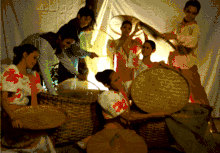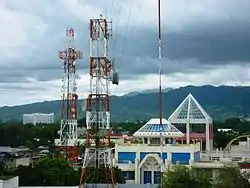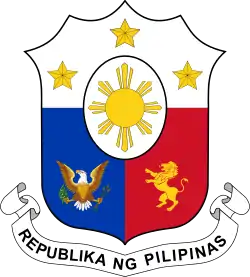Mass media in the Philippines
In 2004, the Philippines had 225 television stations, 369 AM radio broadcast stations, 583 FM radio broadcast stations, 10 internet radio stations, 5 shortwave stations and 7 million newspapers in circulation.[1]
| Part of a series on the |
| Culture of the Philippines |
|---|
 |
| People |
| Languages |
| Traditions |
| Cuisine |
| Festivals |
| Religion |
| Art |
| Literature |
|

Some media outlets, such as RPN/IBC (television) and the Philippine Broadcasting Service (radio), are government-run. Most outlets are privately owned.[1]
The most widely read newspapers are the Manila Bulletin, The Philippine Star, Philippine Daily Inquirer, Business Mirror, and BusinessWorld.[1]
Media culture
Much media ownership is concentrated in the hands of prominent families and businesses. Consequently, some reports tend to be one-sided presentations favoring special interests. The privately-owned press also tends toward sensationalism at times.[1]
While the media companies are predominantly owned by moneyed and influential tycoons, the Filipino readers are given the option with the advent of the new media and this has leveled the playing field. Reputable online news publications or news portals, blog sites, and other online available resources has disrupted the readership of other giant news media companies.
Some giant media companies in the broadcasting industry have adapted also in the online news portal this include GMA Network https://www.gmanetwork.com/news/, ABS-CBN https://news.abs-cbn.com, TV5 https://www.tv5.com.ph and government owned television network PTV4 https://www.ptvnews.ph
This strategy was strongly considered due to the growing number of Filipinos who use social media instead of television in watching the news through snippets or short video clips.
Due to the proliferation of disinformation and fake news, Filipino readers have turned into alternative news sources. There are new players in the online news portal such as POLITIKO a news portal the focuses on Philippine politics https://politics.com.ph. The Philippine Business and News that tackles diplomatic and business news from foreign chambers and embassies, and also business stories of start-ups as well as micro, small and medium enterprises in the Philippines, https://thephilbiznews.com, and the Bilyonaryo https://bilyonaryo.com.ph another source of business news in the country.
The discrimination against new media companies remains prevalent in the Philippines and the big boys club practice on having exclusive beat dominated by people covering that beat is something that is prevalent only in the Philippines unlike in other countries.
Hence, even Muck Rack one of the Top 5 authorities on lists of legit journalists and publications, and Fortune 500 companies connect with journalists through Muck Rack have been strict in verifying legit media company across the world.
Freedom of the press
The Office of the President is responsible for managing the government’s policy toward the press. Freedom of speech and freedom of the press are enshrined in the 1987 constitution. Although independent observers credit the government with respecting freedom of the press in general, the government has been criticized for failing to investigate thoroughly summary killings of journalists and for subjecting journalists to harassment and surveillance.
Violence against journalists
The fifth annual Worldwide Press Freedom Index released by the international press freedom watchdog Reporters Without Borders (RSF) has ranked the Philippines among the worst-ranked countries for 2006 at 142nd place. It indicates the continuing murders of journalists and increased legal harassment in the form of libel suits as part of the problem in the Philippines.[2] Between 1986 and 2005, 52 journalists have been murdered.[3]
See also
References
- Philippines country profile. Library of Congress Federal Research Division (March 2006). This article incorporates text from this source, which is in the public domain.
- "Philippines among worst-ranked countries in press freedom index". freeexpressionasia.wordpress.com/. Retrieved August 22, 2007.
- "52 journalists killed since the return to democracy in 1986". May 2, 2005. Retrieved January 27, 2013.
Further reading
- Reuters Institute for the Study of Journalism, University of Oxford (2020), "Philippines", Digital News Report, UK, OCLC 854746354
